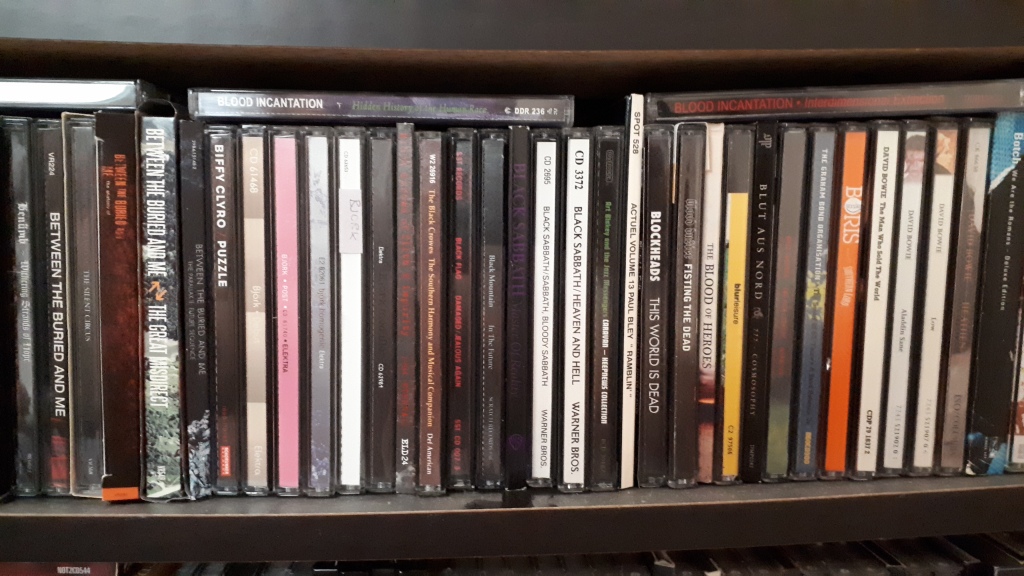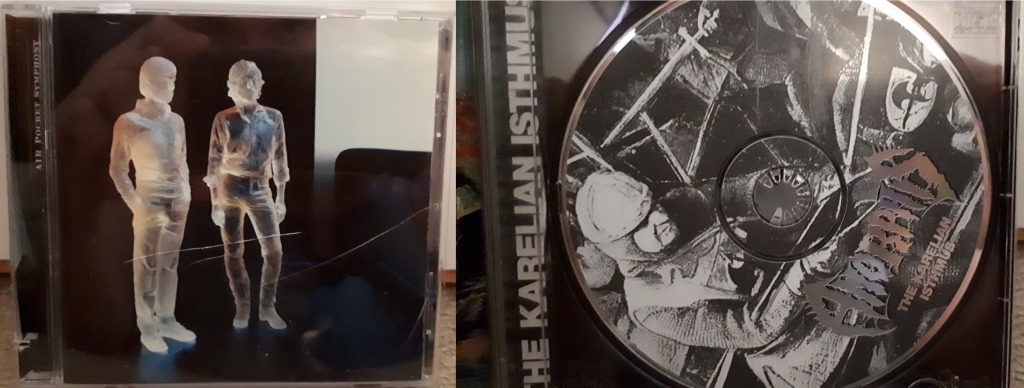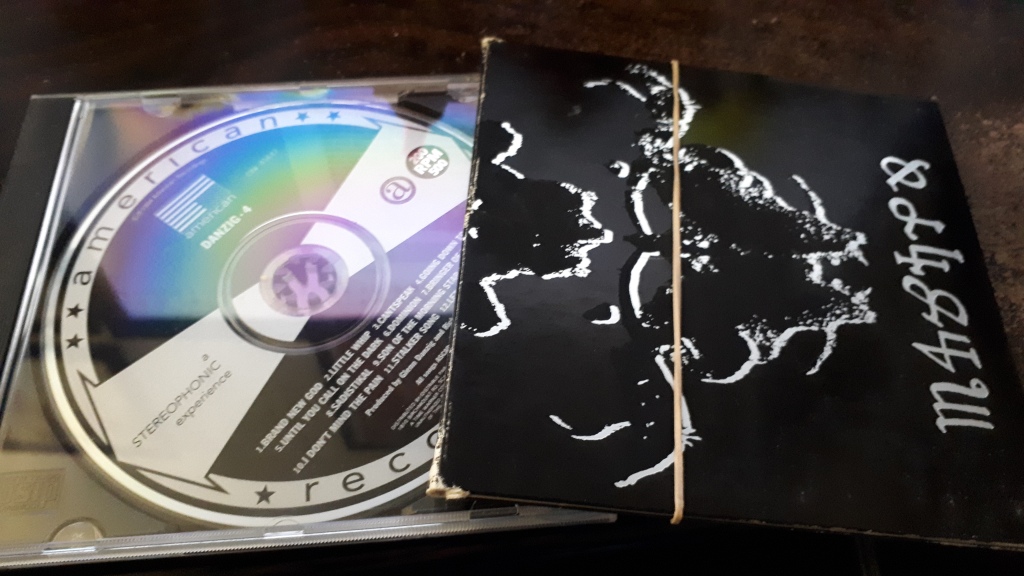Which is the better form of packaging for compact discs, jewel cases or digipaks?
This debate crosses my mind often when I purchase a CD. For anybody that does collect CDs (yes, many still prefer physical media over downloads no matter what the format), you know that that there are essentially two major forms of packaging: jewel cases and digipaks. I know that other styles of cases have been used over the years to store compact disc, such as the longbox, but these two seem to be the most prevalent to date. It may be a bit of a dry topic to some, or an increasingly irrelevant one to many in an age of music streaming apps, but it’s a topic I’ve been meaning to cover since I started this blog.
Why do they call them jewel cases? It’s not like they are made out of jewels. I’m not trying to go all Seinfeld and do a bit. I’m genuinely curious, and can never seem to find a straightforward enough answer. In most cases, jewel cases are made entirely out of transparent plastic, and in some cases a piece of black plastic (or another colour) is used inside as the piece that holds the disc in place. I suppose you can think of these as you would a jewelry case in a store. If you were to remove the cover/liner notes from the front portion of the packaging, you would see a bright, reflective object that, if you are a big enough fan of the music the CD contains, has as much worth to you as any diamond, gem, or gold-infused adornment (if not more).
Digipak makes much more sense from a naming perspective. A CD is a digital storage device, so the case that holds the disc can be referred to as digital packaging, or digipak for short. This type of media holder uses much more cardboard than it does plastic, and the plastic within them is usually glued onto the cardboard to provide the shell in which the disc rests. I was once under the impression that digipak was a brand name because I often see it capitalized, and also alternatively spelled as “digipack”. They seem interchangeable as far as I can tell. The term “digipak” looks a bit cleaner, so I’ll use that spelling going forward.
To analyze them with a broader scope, there are variations on each style of package. With jewel cases, you’ve got thinner varieties that would house CD singles when they were commonplace, as well as ones that hold multiple discs that can vary in thickness and have a hinged plastic insert to hold the discs. My reflections on CD packaging will blur the lines between all these sub-categories, so you may interpret my assessments on what is and is not a digipak incorrect. For instance, I’m placing the likes of digi-sleeves, where discs slide into the cardboard holder rather than being gripped by a plastic spindle, and wallets, where discs are gripped in the case like card holders in a money wallet (as opposed to those zip-up wallets with pages that hold dozens or even hundreds of discs that would often be used while travelling) in the same grouping as digipaks. If I want to rephrase what my debate topic is, you can consider it a question of paper versus plastic, or generic CD holders versus non-generic, or jewel cases versus digi-fill-in the blank.
The debate used to be an easy decision with me: jewel cases all the way! And why was that? Uniformity. There’s not much that can surprise you when it comes to the jewel case in terms of structure, aside from the odd one that comes with rounded corners. Even in that case, the heights harmoniously align on the shelf greater than 99 percent of the time. Such is not the case with certain digipaks. Just take a look at a random row on one of my CD shelves. Doesn’t that jagged edge caused whenever certain digipaks show up bother you? See in particular the slight but notable height differential on Paul Bley’s Ramblin’ in contrast to the neighbouring discs.

I’ve got plenty of overflow where I can’t even display all my CDs properly, so whenever a certain non-standard height occurs, it limits the ability to slide one of my run-over albums on the top of the stack. Also, I’d need to be careful as to what shelves I can use if I wished display all my CDs on them alphabetically (with my preference being by artist across all genres). Not a world-breaker, but it’s worth considering.
Replace-ability is the other major factor that works in the jewel case’s favour, and I’d say this is the most endearing quality. It doesn’t matter how rough the casing is handled, you have the peace of mind of knowing that should it undergo significant damage, you can replace it. I understand all too well that in spite of the rigidity of the jewel pack, damage often occurs. To use an expression that my father loved to use, it’s “Murphy’s law” – any thing that can go wrong will go wrong. I order CDs online at a good frequency, so when the album is in a jewel case, a slight crack on the front plastic is relatively normal. One on the back plastic isn’t out of the ordinary either, but I don’t look at the back with as much frequency anyway because the graphics, song titles, etc. are often duplicated on the back of the inner booklet as well. If the case is cracked at the hinge, that’s when it starts getting annoying. If you don’t have a replacement cover right away, or if the break occurs so the front plastic can no longer click into the back, you either have to let it hang loosely or fasten the parts together with a rubber band or by some other means.
The worst of all is when the teeth in the center of the case are broken so that not only can the disc no longer be gripped as effectively, but you’ve got to take the case apart to rid yourself of those knocked-out teeth that will make a pesky rattling noise every time you pick up the CD. Depending on the tightness of the plastic, you even stand to make further damage by doing some clean-up work. Still, just as long as you don’t do any damage to the insert at the back of the case, a fresh jewel case will put you back in business for when your old one looks like it had gone a full twelve rounds with Tyson. As it can become a full-time job tracking down replacement cases, I’ve got plenty remaining in my possession that have seen better days. See my copies of Air’s Pocket Symphony and Amorphis’ The Karelian Isthmus for such common samples of battle damage.

This may not be as noticeable in a brick and mortar music store because should the manager choose to, they can ship back a case that looks as if it has gone through the ringer with more ease than someone that orders an album through mail. Or at least I’d imagine they would because considering that they deal in bulk orders, their standing as a retailer would be higher in priority with distributors than some schlub off the street. So what is a guy like me to do to get a mint jewel case? As I’ve indicated with my two cracked cases above, replacing jewel cases seems harder to do now than it was ten to fifteen years ago. Back in my day (I say imagining myself to be a couple decades older than my birth certificate indicates), I could stroll into practically any dollar store or office supplies outlet and get some cases sealed in shrink-wrapped bundles of three, five, ten or more depending on the store. Nowadays, your best bet is to go to a yard sale or flea market and buy an inexpensive disc solely on the condition of re-purposing its shell for a different album. It’s not really something I think about doing when browsing used CDs, and it’s not necessarily ideal, but the point is that you’ve got options. Still, I’m hesitant to make another disc homeless unless I know for certain it’s not working properly.
On the other hand, what can be done with a digipack that gets damaged? You’re pretty well out of luck in that regard. I own a few digipak albums that I purchased second-hand that came with jewel cases attached to them via rubber bands for this specific reason. Seeing that used CD stores deal with a high volume of music, they know you may need a backup case in the event of digipak damage or to simply preserve the original packaging. As an example, I’ve kept the jewel case that my copy of Danzig 4 was bonded to it by rubber band at the store. Why let a clean case go to waste?

While we are back to talking about them, what is the main advantage of the digipak? If we are handing out style points, the digipak is the hands-down winner. How these cardboard-based compact disc containers are shaped from a height perspective bother me, but there’s much to admire about the aesthetics. The level of creativity can rival that of vinyl packaging albeit on a smaller scale. One of my favourites in this regard is the case for 10,000 Days by Tool. I didn’t think much of it when I first made the purchase as it was rather lumpy and didn’t store all that well. The front of the case contains a set of glasses to look in, and when set up properly acts like a stereoscope (the use of two side-by-side, two-dimensional photos to create a three-dimensional image) with the photographs in the album’s liner notes. This was another triumph by Alex Grey, who along with his frequent collaboration with Tool has also had his art commissioned for albums by artists including The String Cheese Incident (Untying the Knot), David Byrne (The Visible Man), and Nirvana (inner artwork on In Utero). My mother is a big fan of that sort of 3-D photography, which along with the inventiveness of it has helped it grow on me the longer I’ve owned it.

Another album I think does a nice job of its digipak is Heliocentric by The Ocean. It contained a set of tarot card-sized pieces of artwork that came bound together in a paper band and slide into a pocket in the middle of the gatefold design.

They pretty much give a visual summation of the creation of the universe from a Christian faith-based perspective, and the lyrics (which are printed on the backs of the cards) show this while simultaneously adding critiques. The album’s follow-up sequel Anthropocentric, continues the theme in the lyrics, but the creative visual design elements were abandoned. As much as I like the design of the Heliocentric sleeve overall, which incorporates astrological charts and calendars, the manner in which the CD is sitting in the case irks me. It’s always shifting around, rubbing without much protection, and the cardboard that sits atop the disc could easily bend or break in the wrong hands. Still, the look of it I do like quite a bit.

The sleeve style of package works best for records, which is why certain varieties of these sleeves are classified as mini-LP. Scuffing from sliding around in the wriggle room in the cardboard, in my experience, seems highly probable. This can make resale of CDs slightly more difficult, but I’ve got CDs that look near mint that have skipping issues, and others that look like Edward Scissorhands was the previous owner that play fine.
From a collector’s standpoint, one thing that I’ve been mindful of in recent years is the promotional stickers that comes on the outer wrapping of new album. There would really be no effective way to tuck these things into a jewel case sleeve. They don’t really account for much extra space. You ever have a product catalog thrown into the middle of a jewel case? I have at least one album issued by Magna Carta Records where the additional advertisement simply sits between the CD and top of the case, making it so that either rattles around or makes the case more difficult to close if you don’t insert it perfectly. I like holding onto such things, so that aspect can be quite upsetting. And when it comes to a promotional sticker, if a digipak comes in a wallet-style, a promotional sticker that once sat on the shrink wrap can find a much better home placed inside one of the openings and folds in that package, but in a jewel case I find such things can fall out of them with greater ease.
Those who are concerned about environmental issues may lean towards the digipak. I’ve had multiple albums come in this style of packaging that list phrases along the lines of “This package was created using recyclable materials”. That could be a very strong plus towards this format. On the other hand, the most pro-environment stance would be to just go digital, would it not? That’s difficult to say. Some studies have shown that greenhouse gas emissions are on the rise in the digital era despite less physical album storage required to date. Plus, it’s not as if you chose to keep yours CDs and ditch their outer casing that you could simply throw it into your recycling bin. In Canada, we aren’t even supposed to put our Tim Hortons cups with our recyclables (though change seems to be on the way), and if it is at all plastics-based, Canada apparently only recycles around nine-percent of its plastics.
I’ve debated throwing the longbox format into the argument on the side of digipaks, but maybe it’s a different category altogether. I don’t own any of the longbox-style CDs from the late-’80s and early-’90s, and I rarely even see them in the wild (I’m more accustomed to seeing Sony Playstation games in longbox form than I am compact discs). However, I have a few digipaks that have heights that are rather comparable. I own so few of these that I don’t fuss over how to store them, but I could only imagine if I did. That line of thinking made me wonder what it would be like if the longbox approach was applied to records. Wouldn’t that be something if you had a double or triple LP set and it was multiple times higher rather than thicker! Given shelf heights, there would be next to no chance of that happening, but then again why was that a thing for CDs given what the standard CD shelf heights are? In reality, it seems the use of longbox CDs and cassette tapes came out of the desire to match the heights of records on music store racks rather than being a means for permanent household storage, but given the collector-driven world out there, there’s still got to be a solid second-hand market out there for this format.
Anyway, with the dimensions on certain CD cases being troublesome for storage, that’s precisely why I put my two Endangered Blood albums where I keep my music DVDs because putting them elsewhere is less ideal. For reference, here’s a size comparison against Forever by Cranes, which is in a standard-issue jewel case.

With all that terrain covered, where do you fall on CD packaging? Do you have a preferred format, or are you a staunch supporter of one of them? I’ve found that I have no strong leanings at the moment because there are correct and incorrect ways of packing CDs that both basic styles hit upon. Ultimately, it’s all about what the music within means to you, be it Beethoven’s 5th Symphony or a recording of a drunk jam session with your college buddies.


One thought on “Packaging Perspective: Jewel Cases vs Digipaks”